Mindfulness exercises and mindfulness in yoga

Mindfulness Exercises – anyone can do it!
Those of us who practise mindfulness exercises and who meditate, enjoy happier, healthier and more successful lives. Isn’t it time we all enjoyed these benefits? Some of us may have already tried mindfulness or meditation, but struggled with the regular commitment or thought that because our mind kept wandering we weren’t suited to it! This is just not true! Any new skill needs practise and mindfulness exercises are no different. So let’s try again and we will soon understand how it can enrich our lives!
Most of the mindfulness exercises below can be practised as an individual or in a group session. Mindfulness has been shown to be as effective as cognitive behavioural therapy (CBT) in group therapy and in many cases, more effective when practised in a group than as an individual. Participating within a group can also help to reduce social anxiety, but if we feel more comfortable practising alone the exercises are still very beneficial.
6 Mindfulness exercises to try today!
- The Raisin exercise – this is a good beginners exercise to start the process of practising mindfulness. We may feel a little silly to begin with, but the object of the exercise is bring our minds to the ‘present’ – to what is immediately in front of us. It can be practised with any type of food, but is best with something with an interesting and unusual texture, smell and/or taste. So…we take a raisin and imagine that we’ve never seen one before. We should take careful note of how it looks and feels and its smell and taste. If we do this, we would find it difficult to avoid practising mindfulness and becoming more aware of what is in front of us in the present moment.
‘Focusing on the ‘raisin’ and everything about it prevents us – at that precise moment – from giving attention to, and worrying about, everything else that is happening in our lives’
- Mindful seeing exercise – this is a simple exercise, which only needs a window with any sort
 of view. We can stand or sit at the window and look at everything we can see. We should not just think ‘bird’ or’car’ etc – instead we need to notice the colours, patterns and textures of everything. Be aware of the movement of the leaves in the breeze and all the different shapes you can see just in this small viewpoint of the world. Imagine looking at it as if we have never seen these types of things before. Be observant, but not critical and be aware, but not fixated. If our mind wanders, gently bring your attention back by noticing a colour or shape, to return ourselves back to the ‘present’.
of view. We can stand or sit at the window and look at everything we can see. We should not just think ‘bird’ or’car’ etc – instead we need to notice the colours, patterns and textures of everything. Be aware of the movement of the leaves in the breeze and all the different shapes you can see just in this small viewpoint of the world. Imagine looking at it as if we have never seen these types of things before. Be observant, but not critical and be aware, but not fixated. If our mind wanders, gently bring your attention back by noticing a colour or shape, to return ourselves back to the ‘present’.
‘This exercise will only take a few minutes, but will open our eyes to a whole new world of discovery from our otherwise commonplace view’
- Mindful listening exercise – two or more people are needed for this exercise. Mindful listening is a significant ability, whereby attention is focused on the speaker – concentrating on their words – so that they feel fully ‘heard’. Mindful listening generates an inner stillness for both parties, as the speaker will feel free of any judgment by the listener, and the listener will be free of rambling thoughts, allowing them to learn valuable communication skills. Firstly, ask the speaker to talk about something that stresses them and something they enjoy. Whilst talking, they should pay attention to their own thoughts, feelings and sensations when they speak about the stressful thing and also when they speak about the positive thing. The listener should also observe their thoughts etc too and once the speaker has finished we should review the following:
- How did the speaker feel when talking?
- How did the listener feel when listening?
- Was there any mind-wandering? And if so, what was the distraction and what brought their attention back to the ‘present’?
- Did the listener feel judgmental in any way? And if so, how did that feel?
- Did the listener feel any empathy? And if so, how did that feel?
- How did the speaker’s body feel just before speaking? And how did it feel just after speaking?
- What are they both feeling now?
- How do they think they would feel if they practised mindful listening with everyone they spoke with? Would that change how they interacted and related to others?
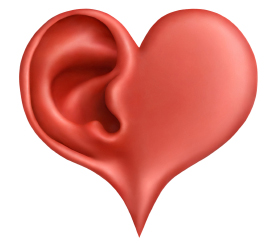
‘How would it feel if we chose to pay attention with curiosity, kindness and acceptance to everything we say and everyone we listen to?’
- The self-compassion pause exercise – this is an ideal exercise for those of us who may find it easy to give compassion to others, but who struggle to show ourselves the same compassion. It also helps to practise mindfulness by bringing awareness to our emotions and staying in the ‘present’ with them. So why should we practise self-compassion? We all know those people who are their own worst critics! The way we talk to ourselves is vitally important for our well-being. It’s essential that we feel accepted and supported by that little voice inside us. Our thoughts, and how we perceive ourselves, greatly impacts our well-being.
‘Imagine we are on a journey with someone for many decades…wouldn’t it be paramount that our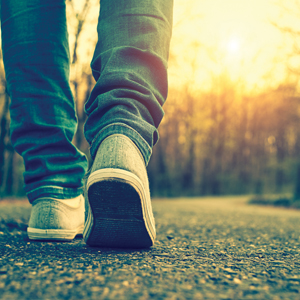 relationship was excellent?
relationship was excellent?
So what about the journey we’re on at this moment – the one called Life? How is our relationship with that voice in our head? Is it a positive, supportive relationship or is it our worst critic?’
- Self-compassion means being gentle, kind and understanding of ourselves. Whilst practising self-compassion we become more aware of our limitations, but we must learn to accept that none of us is perfect and any mistake we make helps us learn and grow. We should give as much patience, kindness and non-judgmental understanding to ourselves as we do to others, by doing this we will have a profound effect on our well-being and enhanced life satisfaction. To begin practising self-compassion we need to become more aware of our feelings with a focused mindfulness, by pausing our thoughts. We then put a hand over our heart or give ourself a hug and take a few deep breaths. The next step is to acknowledge our suffering – the idea is not to be overcome by our feelings, but just to recognise them as real and allow ourselves to feel them. Finally, although this can be difficult, it is crucial to vocalise the following:
- ‘This is suffering‘ (or words to that effect)
- ‘Suffering is part of being human‘ (recognise that we all suffer and struggle at times)
- ‘I love and accept myself just as I am‘ (or a similar phrase which offers compassion)
‘You can search throughout the entire universe for someone who is more deserving of your love and affection than you are yourself, and that person is not to be found anywhere. You yourself, as much as anybody, deserve your love and affection’ Buddha
- The self-inquiry meditation exercise – the aim of this exercise it to be aware of ourself and to bring awareness to the source of all that we are. It is sometimes very easy to be distracted from this by everyday life. Self- inquiry can foster a sense of peace and openness to experiences. It can continue for as long as we wish and is often not so easy to practise as it requires us to focus on ourself, which many people struggle with! It is sometimes easier to practise the self-compassion exercise first. When we find ourselves distracted by jumbled thoughts, we should just bring ourselves gently back by asking ‘Whose thought is this?’ To practise the exercise we need to find a comfortable seated position and let ourself settle into our mind and body. We should clear out mind of it’s usual chatter and let go of our thoughts. Focus our attention on who we are? How does it feel? What makes up our inner self?
‘Self-inquiry can help bring awareness to the one who is dealing with all these thoughts and feelings – you!’
- The five senses exercise – this is an easy exercise to do when we have little time to practise a full body scan etc. It can help us to bring our awareness to the ‘present’ in just a short time. All we need to do is to notice something we are experiencing with each of the five senses:
- Notice five things we can see – take a glance around to five things we can see, choosing something different that we may not normally notice, such as a shape of a tree or small crack on the pavement.
- Notice four things we can feel – bring our attention to four things we are feeling, such as the softness of our sweater, the texture of the leaves on the tree as we past by, or the breeze on our cheek.
- Notice three things we can hear – take a moment to listen to three things we can hear, the sounds of a jet plane in the distance, the thrum of a lawnmower nearby and the beautiful birdsong all around.
- Notice two things we can smell – bring our awareness to smells we may not normally notice, whether pleasant or otherwise. Maybe the breeze is bringing the smell of that newly mown grass if we’re outside, or the smell of our newly washed sweater.
- Notice one thing we can taste – focus on one thing we can taste right now. It could be the coffee in front of us, the blueberry muffin we can take a bite of, or simply notice the current taste in our mouth.
Mindfulness for Success in life (online course)
Mindful Yoga – bringing mindfulness onto the mat
Practising mindfulness meditation techniques on the yoga mat can bring a sense of ease which filters through into our whole life. Some of us may have already experienced occasions in a yoga session where we’re standing in ‘Warrior Pose (Virabhadrasana)’ for example and we reach through our back foot as our arms reach up towards the ceiling/sky.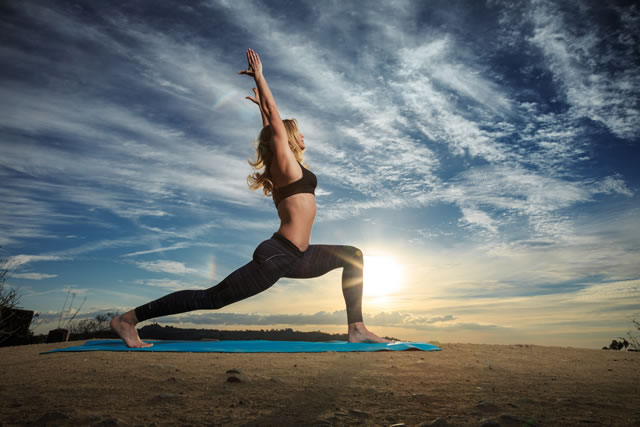
As we hold the pose, we notice our front thigh burning, our shoulders tensed and our strained breathing. Still holding. We begin to struggle and are desperate for the teacher’s nod to release us, whilst our breathing becomes shallower. Still holding. Surely she’s got to realise that’s enough…has she gone to sleep? We think ‘this is why yoga isn’t for me!’ Our thigh is shaking now, we mentally check out and frustrated, we drop our arms and look around.
Many of us will recognise that scenario – but imagine having the same thoughts and feelings – annoyance, boredom, impatience, tension – and instead of reacting, we simply observed our sensations. We remember that the pose, just like everything else we deal with in life, will end. We remind ourself not to get wrapped up in ourself and instead, when our thighs are burning, we enjoy the knowledge that the exercise is benefiting us and feel grateful we have found the time for ourselves to practise the yoga. We can then bring our attention back to our breathing and just be aware of our sensations and feelings before the teacher brings us out of the pose. This mindfulness in yoga brings our awareness into the ‘present’, just noting and accepting how we are feeling, without judging or reacting and will make us feel so much better than in the first scenario! Practising mindful yoga will allow us to be aware that when our thigh is shaking in the standing pose, it doesn’t overshadow our whole experience and that we do not need to change it, but merely accept it as one small sensation in the whole moment.
If we were to similarly use this mindfulness in a different situation – for example when our whole body is shaking with nerves before a job interview – we can accept and understand that sensation, but not allow the feeling to affect our confidence or the experience.
Mindfulness’ great advantage is that it works within any style of yoga. In some styles of yoga (Yin for example), poses are held for a long time, which can bring intense physical sensations, along with a steady desire to exit the hold. This is when mindfulness can be particularly helpful. In holds which take us into deeper places of pain or discomfort, mindfulness can provide the support for that experience, whereby the suffering can remind us to come back to the ‘present’ and just observe the truth of our agitation. We should notice also how we readily compare ourselves with the people around us – ‘They are stretching further than me or reaching higher’ and merely recognise these as thoughts and behavioural patterns and just accept our thoughts and then bring ourselves back to the ‘present’ again.
How mindfulness in yoga can enhance your experience in the class
Yoga can help us become more mindful, as there can be many things beyond our control; from noisy traffic; we could be feeling restless for some reason; our hamstrings a little tight; or even the person next to us dripping sweat onto our mat! Practising mindfulness in these situations allows us to fully benefit from the yoga class by becoming less reactive to the things which would normally irritate us.
Mindfulness can make us aware of our common tendency to stop short of our limit or indeed push too hard past it and possibly cause problems. It can also boost a yoga session if we find ourselves on ‘auto-pilot’. Mindfulness can help us open more deeply to our yoga and extend that feeling for the rest of the day, slowing us into the practise and truly being ‘present’ with what arises.  The ‘Mountain pose (Tadasana)’ for example can often be thought of as just something we do between more important poses. However, if we practise mindfulness during the pose we will be completely aware of the feeling of our feet on the mat and everything rising from there – the moment of sensation and our breath.
The ‘Mountain pose (Tadasana)’ for example can often be thought of as just something we do between more important poses. However, if we practise mindfulness during the pose we will be completely aware of the feeling of our feet on the mat and everything rising from there – the moment of sensation and our breath.
Practising mindful yoga helps us to deal better with the everyday stress of work, relationships and life in general. It is not about escaping or creating a blissful state, but more about changing our normal thought processes away from attachment or aversion, to realising there is no fundamental problem and everything is ok. Mindful yoga will show up in all parts of our life as increased patience, curiosity, kindness, the potential for ‘letting go’ of issues and the recognition of basic goodness in ourselves and others.
A selection of 6 mindfulness yoga poses:
- The Corpse pose (Savasana)
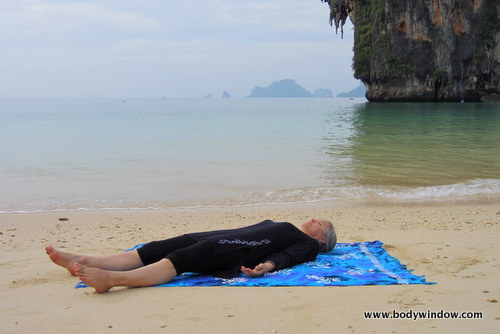 – this is one of four main meditation poses taught by Buddha, sometimes used at the start of the class and always at the end. We should lie on our back, with feet about 12-18 inches apart and arms at side just a few inches from our torso, with palms facing up. Allow our body to surrender to gravity. We then follow these mindfulness breathing exercises
– this is one of four main meditation poses taught by Buddha, sometimes used at the start of the class and always at the end. We should lie on our back, with feet about 12-18 inches apart and arms at side just a few inches from our torso, with palms facing up. Allow our body to surrender to gravity. We then follow these mindfulness breathing exercises - The eye of the needle pose – from the Corpse pose we should bring our feet near to our buttocks, hip-width apart. Place the outer right shin on the left thigh, drawing
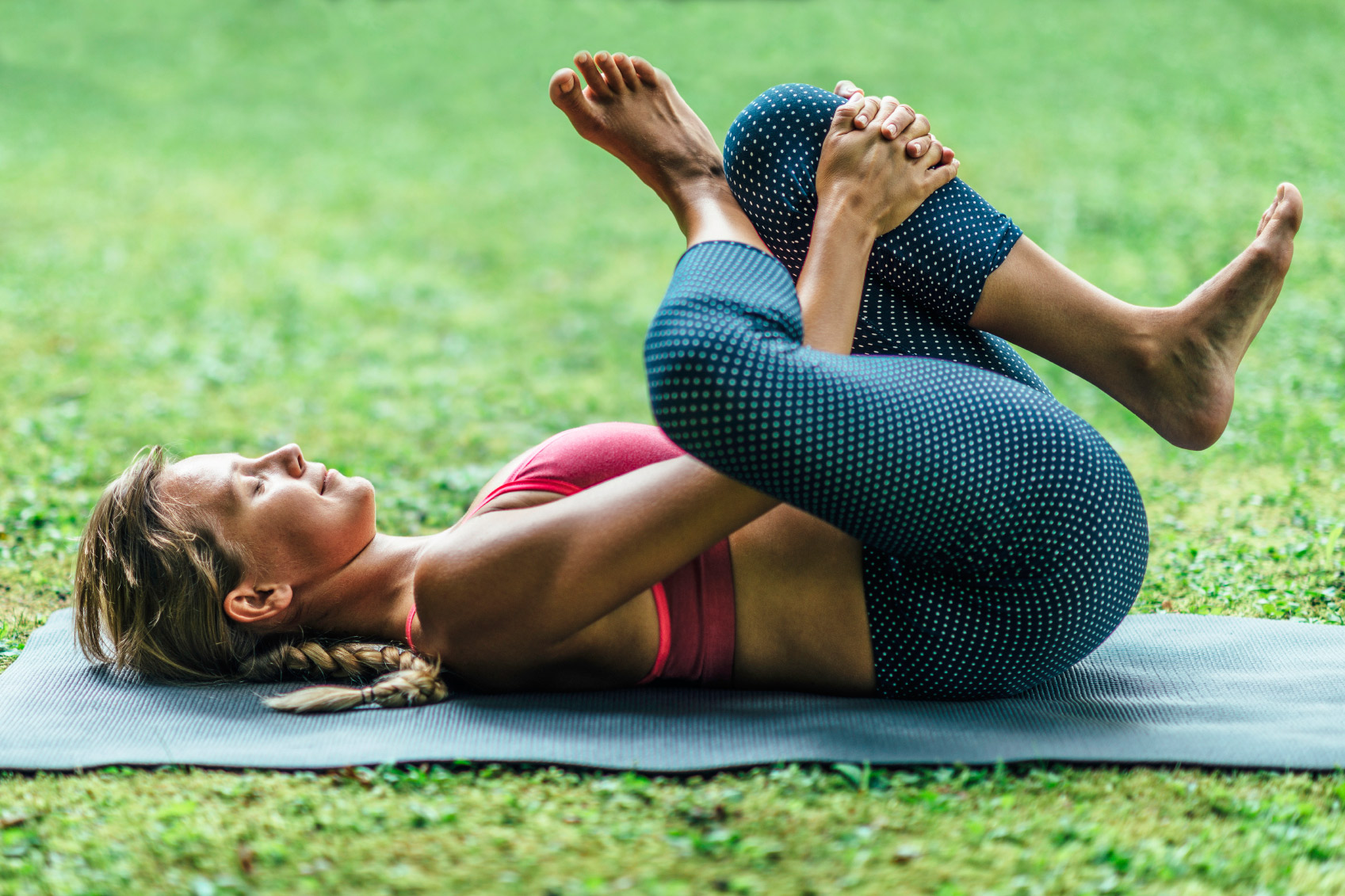 the left knee toward our chest. We then reach between our legs, clasping our hands under our left leg. Notice whether we held or restricted our breath as we moved into the stretch and then continue to let the breath flow naturally. There may be stretching sensations in the right hip and we may feel some resistance to them, which could cause us to tense the surrounding muscles. If we can release this tension, practising mindfulness will help us to observe how the sensations change as we maintain the stretch. Continue this as we release and repeat on the other side. We may find that one hip is tighter than the other and so cause stronger sensations – try to feel the difference between each side, without judgment.
the left knee toward our chest. We then reach between our legs, clasping our hands under our left leg. Notice whether we held or restricted our breath as we moved into the stretch and then continue to let the breath flow naturally. There may be stretching sensations in the right hip and we may feel some resistance to them, which could cause us to tense the surrounding muscles. If we can release this tension, practising mindfulness will help us to observe how the sensations change as we maintain the stretch. Continue this as we release and repeat on the other side. We may find that one hip is tighter than the other and so cause stronger sensations – try to feel the difference between each side, without judgment. - The Cat Cow pose – come onto hands and knees, placing hands immediately under our shoulders and knees under our hips. Ensure the shoulders are down and relaxed. As we exhale, round the back and scoop the tailbone between our legs, letting the head tilt to gaze back toward the thighs. On the inhalation, tilt the pelvis forward, opening our belly toward the floor, letting our spine move into the torso, creating a gentle backbend. Reach the crown of our head and tailbone up toward the ceiling/sky, but be careful not to reach upward with your chin, as it will compress the back of the neck. Move back and forth between the two for a few
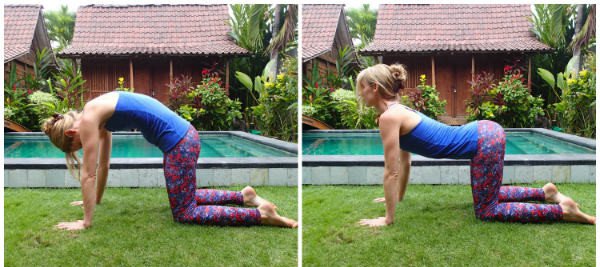 breaths. Whilst we are continuing to coordinate the movement with our breath, we should let the timing of the breath determine our pace. After going back and forth a few times, we may notice the mind wandering, which is quite normal with anything repetitious, but we should gently come back to our breath whenever this happens, to keep our body and mind connected.
breaths. Whilst we are continuing to coordinate the movement with our breath, we should let the timing of the breath determine our pace. After going back and forth a few times, we may notice the mind wandering, which is quite normal with anything repetitious, but we should gently come back to our breath whenever this happens, to keep our body and mind connected. - The Downward-facing dog pose (Adho Mukha Svanasana) – directly from the Cat-cow pose, we should tuck our toes under, lifting our hips and straightening our legs.
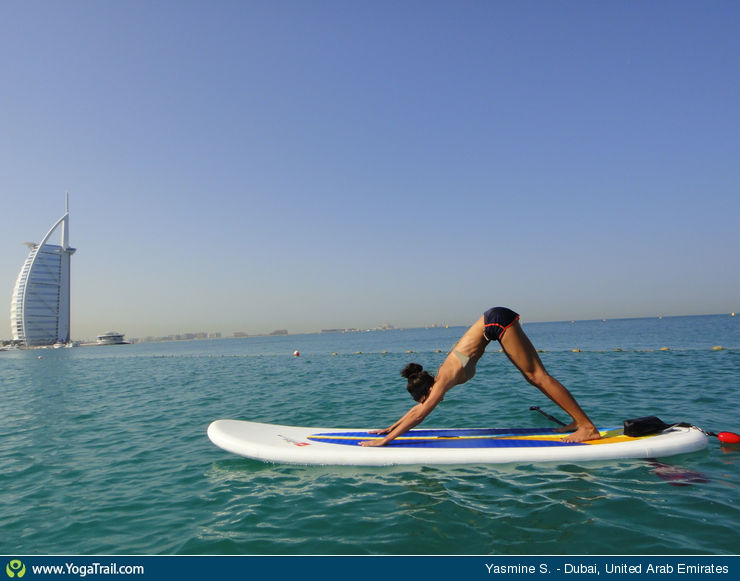 We can explore the pose by bringing the heels to the floor one at a time, coordinating our breath. Notice if our mind wanders and bring it back to our breaths. Stay in the pose for between 8-15 breaths, staying aware of our sensations and how the experience constantly changes. Moment by moment and breath by breath, the posture will re-create itself.
We can explore the pose by bringing the heels to the floor one at a time, coordinating our breath. Notice if our mind wanders and bring it back to our breaths. Stay in the pose for between 8-15 breaths, staying aware of our sensations and how the experience constantly changes. Moment by moment and breath by breath, the posture will re-create itself. - The Half Lord of the Fishes pose (Ardha Matsyendrasena) – sit in a cross-legged position, sliding our left foot under our right thigh, bringing our left heel to rest on the outside of our right hip. Then cross our right foot over the left thigh so that the sole of our right foot is firmly on the ground.
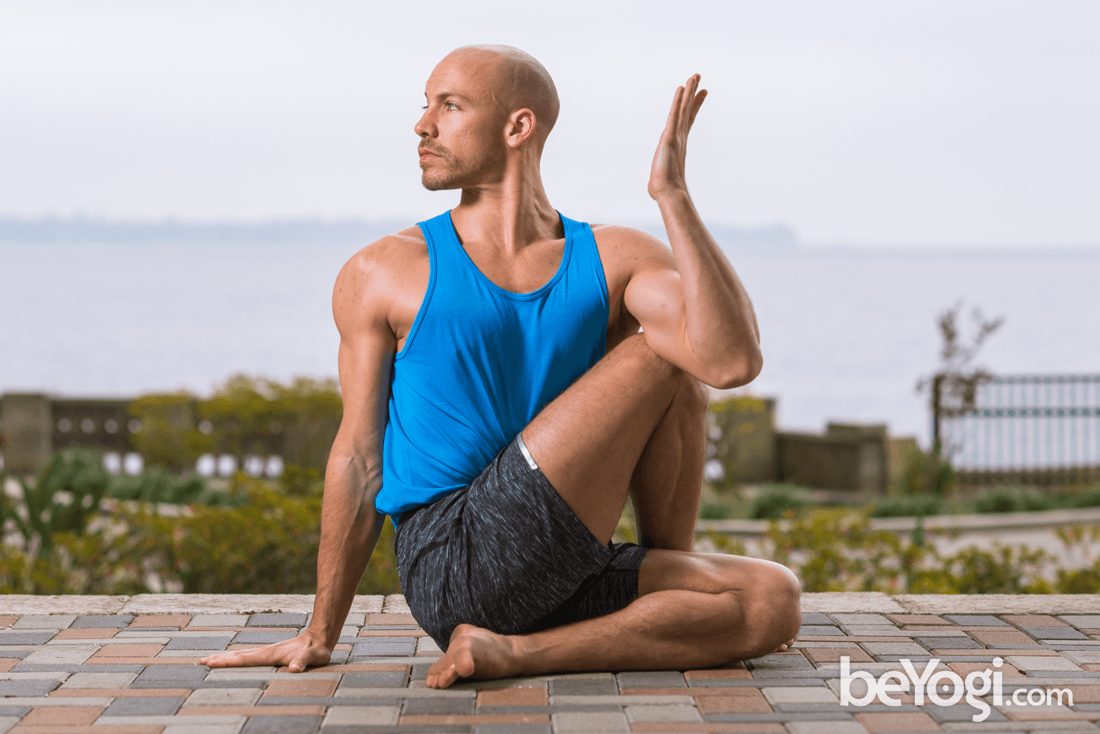 Hug our right leg just below the knee, with our left arm and use our right hand to press into the ground behind. Extend the spine upwards, turning our head to the right, keeping the neck relaxed. Stay present with our breath, allowing it to guide us as we exhale and gently untwist. Repeat on the other side.
Hug our right leg just below the knee, with our left arm and use our right hand to press into the ground behind. Extend the spine upwards, turning our head to the right, keeping the neck relaxed. Stay present with our breath, allowing it to guide us as we exhale and gently untwist. Repeat on the other side. - The Seated Forward Bend pose (Paschimottanasana) – we sit with our legs in front of us, pressing the backs of our thighs, calves, and heels into the ground. Reach through our heels, flexing our toes towards our head. Press our hands into the ground by our hips and lift our chest. If the lower back rounds and our weight is on our tailbone, sit up on a blanket for support. We then grasp our shins, or feet if possible, slightly rotating our thighs inward and keeping our groin relaxed.
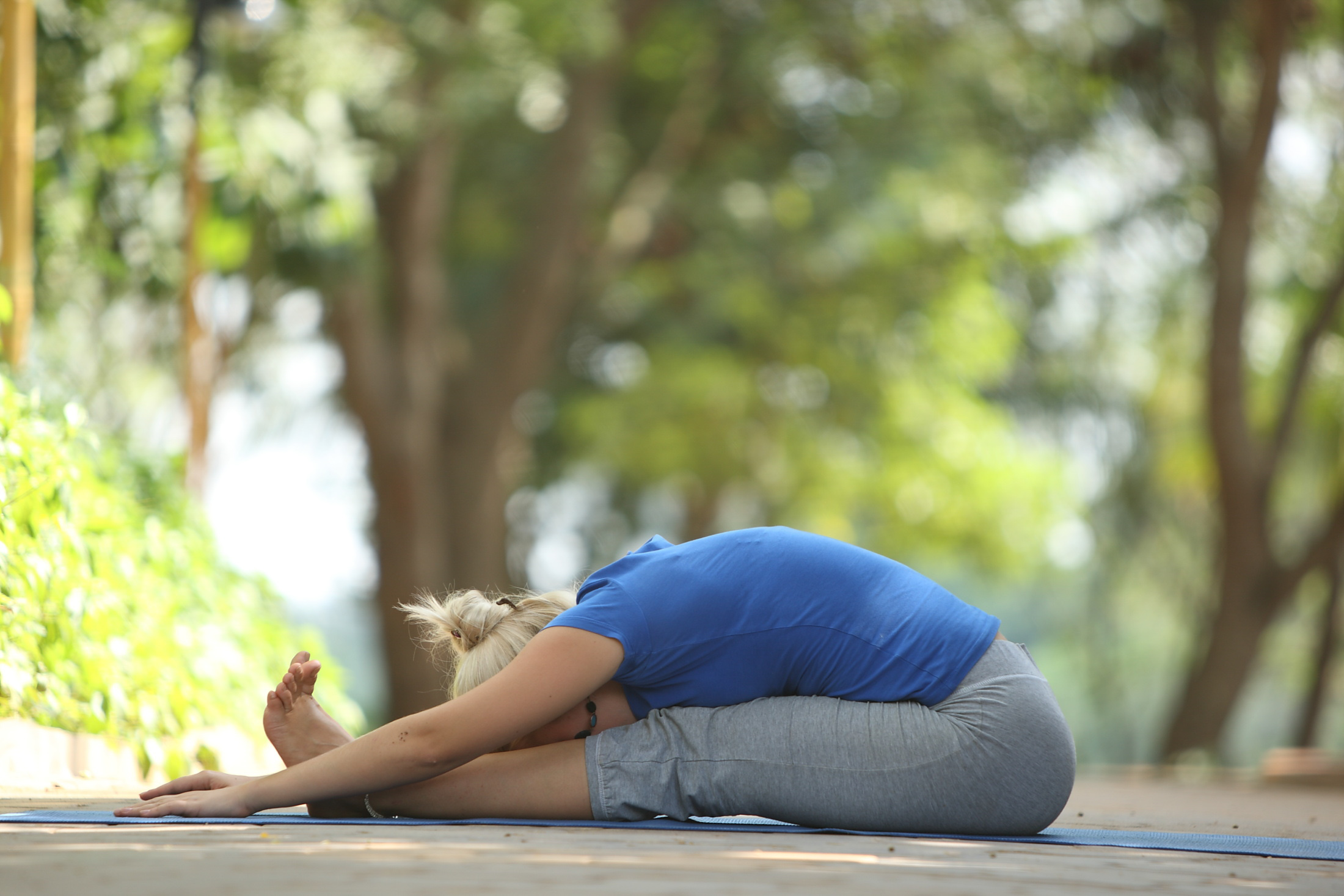 We lengthen our torso over our legs, keeping the lower back from rounding. Feel our breath move within us, surrendering to the posture and letting go of any thoughts or feelings of our position and just being aware of where we are. Notice how trying to prolong or create pleasant feelings is in itself a form of tension.
We lengthen our torso over our legs, keeping the lower back from rounding. Feel our breath move within us, surrendering to the posture and letting go of any thoughts or feelings of our position and just being aware of where we are. Notice how trying to prolong or create pleasant feelings is in itself a form of tension.
CalmingBreath Zafu meditation cushion
30 days of Yoga video – youtube
Yoga stretch strap belt
Multi colour yoga blocks
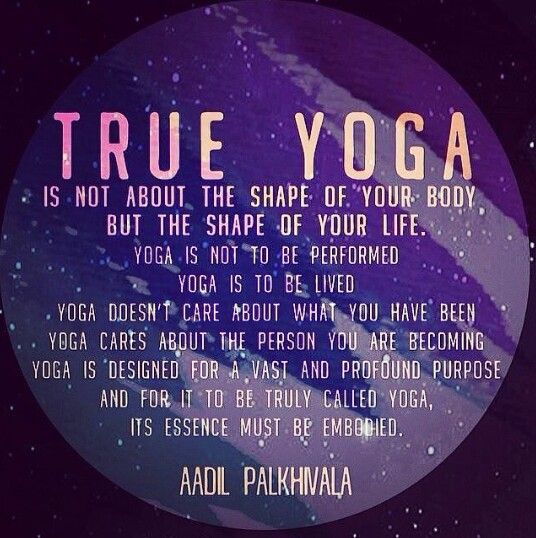
TRUE YOGA is not about the shape of your body, but the shape of your life. Yoga is not to be performed. Yoga is to be lived. Yoga doesn’t care about what you have been. Yoga cares about the person you are becoming. Yoga is designed for a vast and profound purpose and foe it to be truly called yoga, its essence must be embodied. Aadil Palkhivala
© 2017 Mindfulness4u.org All rights reserved





